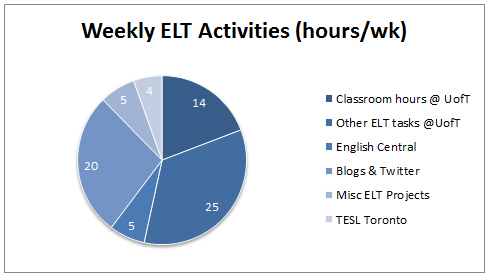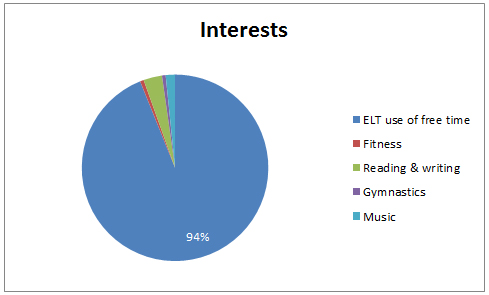Experiencing our industry outside the classroom contributes to an expanded knowledge and understanding of so many aspects of ELT. It can also help you to appreciate teaching itself when you feel less motivated. With Twittering educators, blogging resources and virtual workshops increasing at a fantastic rate, avoiding burnout from the stresses of the classroom and gaining inspiration and motivation from others has never been more accessible. Problems solved, right? I’ve found avoiding burnout isn’t so simple.
When you look at how I spend my ELT time during the week, it looks as though I spread myself across a wide variety of aspects, with teaching and directly-related classroom hours at my day job (the University of Toronto) pretty much well balanced with the hours I spend collaborating with other teachers, blogging and at English Central (see previous post). A great balance of nearly 50/50. You have a well-balanced ELT time, Tyson. Congrats! Well done! Burnout averted! However, like all statistics, this can be misleading.
If we expand outwards to include the other ways I spend my free time (outside the hours I’m paid for by my UofT position), it becomes more apparent that that balance is less…well. Over the course of a week, not including sleeping, eating or grooming, socialising with friends and family come out as the whopping second. Of course, most of my friends are other ELT educators and inevitably our conversation turns to our students and programs at some point. It’s also a little hard to entirely separate “TV & Internet” from ELT as I tend to multi-task during these times too. I also have that Teacher Eye that is almost always switched to ON, where anything I see, watch or hear gets converted to possible lesson ideas. Sound familiar?
If you asked me what interests I have outside of ELT, without hesitation I’d list reading fiction, writing short stories and poetry, keeping up with the gymnastics world, fitness (Wii programs, walking with my dog, etc), and listening to and discovering great music. If I zoom out from previous pie charts to only look at the monthly time I spend on what I’d call these primary interests, it becomes even clearer that ELT has taken over my life. It’s no wonder that I’m feeling some ELT exhaustion.
In Shelly Terrell’s Goal 19: Avoid Burn-Out, she challenges teachers to spend at least one hour a week doing something for yourself, apart from teaching and students in order to avoid burning out. I’ll go further in suggesting that you figure out what your ELT:Other ratio is (eg. like I’ve done with the pie-charts in Excel). Similar to how writing down all the money you spend in a month can often shock you into budgeting, you may not realise how much time you actually devote to ELT outside of your classroom-related activities. Though I’ve known for a long time that I haven’t purposed enough time to my other interests (I hear the longing weeps from my pile of books and comics to read behind the cupboard doors), it’s not until I saw it in black and white (or in this case multi-coloured) form that it became glaringly obvious that my road towards burnout is being cemented by my actions (it’s probably at the dirt road point at the moment).
The best of us exert so much of our physical and mental energy into our lessons, our students and our own development as teachers. This can be inspiring (and even necessary) in certain doses, but we also need to broaden ourselves into other interests and devote time to them. Not only will you decrease the threat of burn-out, but what you gain from other interests can bring new perspectives into your teaching. My promise to myself, colleagues and students is to create a better balanced ELT:Interests ratio.
Now, I also ask you: What are your interests outside of ELT and what is your ELT:Interests ratio? Will you try to balance it out better this month?
Thanks for reading. I’m off to get groceries and then read some Batman! =)
Related posts:
Teaching, books & collaboration (@seburnt)
Goal 19: Avoid Burn-Out #30Goals (@ShellTerrell)
Helping colleagues with teacher-burnout (@Marisa_C)




Love the pie charts! You’re awesome! This really gives a visual perspective and I know my graphs would show how unbalanced my life is with work. The thing I struggle with is that for me Twitter and social media fall into a gray category! I really find talking to friends like you relaxing and calming. They fall into a fun category but at the same time I use them for work purposes. Eeeeekkkk so what to do about them gray categories! 🙂
I definitely agree on social media’s greyness. I can’t say I don’t enjoy every minute I spend online, but even if it doesn’t contribute to burnout directly, it still has decreased the time I devote to my other once-burgeoning interests, as I’m sure it may for you too. We all need the friendships and social time we have within out ELT groupings, but we also need time away, which I’m realising I lack. I know you relate. =)
I am terrified of doing my pie chart and finding out my ratio Tyson! I will do it, eventually. But I think you brought up a much needed (at least for me) reflection. Like Shelly and you, there are many grey areas for me, especially when it comes to social media and internet usage. This is something that really hit a chord with me especially because just last week I was out at a bar with friends and kept checking my phone every time there was a beep (a nem email). I didn’t notice how often I had been doing that or how rude I had been to my friends until one of them joked saying next time we went out she’s only do it if I left the phone at home and really joined in. I was mortified. And it made me think.
On the spirit of trying to become a better person I vouch to leave the house – and the computer – for some hours to be out with friends tomorrow. And I’ll try really hard not to check emails or twitter on the phone. 😉 Thanks for the eye-opener! Great post!
So you feel my dichotomous view of ELT vs Other Interest, do you? I can’t say I relate with the phone checking obstacle to socialising. I don’t have any beeps. I do check it on the way home on the bus from the university each day, not to mention on my laptop before I go to work and at lunch and after class and then when I get home from class and then regularly for hours after that. Yes, I need help. LOL
I applaud your promise for tomorrow. Good luck with that. =)
Hi tyson!
What a great way of doing this post – love the pie charts! (But pretty eye-opening results that made me think.)
I cannot remember where I saw this or who said it: we teachers are lucky, “as our job spills into our free time as a hobby we enjoy as well”. I love my work and I am one of those fortunate people who wakes up in the morning and says “Yahooo!”
Sometimes doing too much can be a bit of a no-no though, as we are human too and need some time to ourselves. Of course we love what we do, but as the Ancient Greeks said: Pan metron ariston – everything in moderation!
Excellent way of writing this post and thanks for making us all think. I admire you for everything you do – you’re great and thanks for that!
Thank you,
Vicky
Thanks for the comment, Vicky!
Yes, I thought the graphs were pretty startling and demonstrated my point clearly. You’re right in suggesting that we are lucky that we love what we do. Confucius once said that if you love what you do, you won’t work a day in your life–what can be true for many of us. Still, there are few people who can love what they do so much that nothing else gets attention. We need variety in order to stay sane. What’s yours? 😉
@NoraTouparlaki Yes, I completely understand. I did a post about this once: https://t.co/l4mk29q
[…] Short-term-Take at least one hour for yourself where you don’t dwell on your role as an educator but instead give your time to relax and have some fun. Tyson Seburn, who will be another educator we will Hang-Out with posted a graph of how he spent his time for this goal. Check out Tyson’s post and graph. […]
Hi Tyson,
I love how your presented the way you spend your time using these graphs, such a clear picture.
I work at home, and sometimes I have this feeling that I only work, at the same time, I feel that teaching makes me so happy that I can’t do without it.
I believe that the problem is when we take things to the extremes, when I say “I can’t live without teaching”, I should add, “neither can I live without my family gatherings, and friends, and my walks, and the contact with nature, and my plants and dancing and …”
Debbie
Great additions to the ‘can’t live without’ statement, Debbie. Thanks for giving me some thought to consider. Since this post 2 years ago, I have tried to spread myself across slightly more diverse interests, but I can’t say I’ve lessened my ELT load. It’s just something I accept because I love this industry so much.
[…] ago, I talked about burnout, particularly the path towards it that I and probably you were on. My ELT:Other ratio stared glaringly in my face, mocking my attempts at having a life outside of language teaching. […]
[…] Tyson Seburn focuses on work-life balance. […]
[…] Tyson Seburn – ELT ratio: your path to burnout – here […]